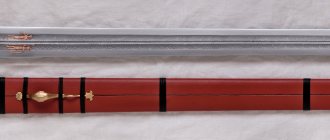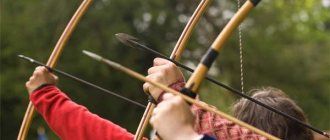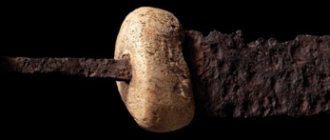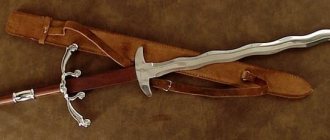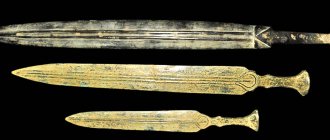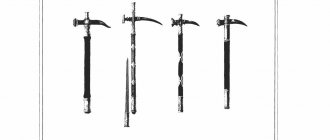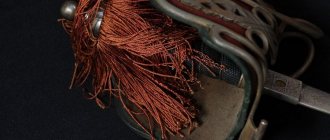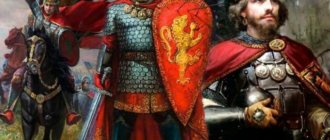Parametric data of spathas and their differences from gladiuses
The spat had sharper conical shapes and ended with rounded tips.
Spatha is characterized by:
- The manufacturing material was bronze, iron or steel;
- The length of a one-handed spatula is up to 13 cm;
- Length – from 60 to 80 cm;
- Blade width 5-6 cm;
- Weight – up to 2.4 kg;
- The damage dealt is slashing and piercing.
Basically, these edged weapons were revered by the Celts, Franks, Germans, and Romans, especially in the cavalry.
A little etymology and history of the name of the sword
The word "spatha" is of ancient Greek origin spathe, meaning "the presence of any wide blade, wooden or metal", as well as "a wide blade in a sword". However, this term "spata" was also adopted by the Romans. The forerunners of the spathas in the 3rd century BC. there were long Celtic swords. The spatha appeared in the Roman Empire in the 1st century as a standard weapon in the auxiliaries. Subsequently, it was the standard sword in heavy infantry, while light infantry used gladiuses. Apparently, the spathas simply replaced the gladiuses for the front ranks to give the infantrymen greater reach during battle.
Archaeologists have found many spathas in Britain and Germany. They enjoyed wide popularity among German warriors, but it is not known for certain from which weapon the evolution of spathas began. Swords remained popular throughout the Great Migration of Peoples in the 4th-12th centuries. There is a possibility that spathas evolved into the knight's swords of the High Middle Ages around 1100. However, this cannot yet be proven, if only because the details of the manufacture of spathas are unknown to researchers of antiquity.
Katana
Thanks to Hollywood and TV, this is perhaps the most recognizable sword in the world.
And although the sharpness of the katana is often exaggerated, the katana remains an incredibly good sword - one of the best cut-and-slash swords in history. The katana first appeared in the arsenal of samurai in the 12th century. Japanese craftsmen make katanas from a special grade of steel - tamahagane. The sword is made from many layers of this high carbon steel and is very flexible. The main purpose of the katana was to provide the highest possible speed for drawing the sword from its sheath and striking. Samurai wore katanas on their belts in such a way that they could draw a sword and strike with one lightning-fast movement
Although, contrary to popular myth, the katana does not cut through a falling silk scarf, its blade is still incredibly sharp. The katana is now one of Japan's national treasures. Any katana made before the beginning of the 20th century is considered a national treasure and can be exported from Japan only with the highest permission of the Japanese Emperor.
Controversy surrounding the origin of spat
Judging by individual specimens of spathas of a later period, which were discovered at the already mentioned archaeological excavations, some interesting versions of their origin have emerged. Some researchers reasonably believe that the inventors of the spat were some representatives of the Germanic tribes. As it turned out, some of them developed this type of bladed weapon several centuries earlier.
Some experts have even suggested that spathas were a kind of broadsword or Viking sword. They also confirmed that this was not a transformation from gladiuses or Celtic weapons, Celtic swords. Over the course of several centuries, spatas practically ceased to be used, and were revived by the Romans.
Some researchers believe that the name of the sword is unlikely to belong to the Germans. They never found any mention that the swords were 100% German in origin. There were such varieties of swords as sweord or bill. However, documentary evidence of their relationship with the spathas has never been established. They were not used in the names of swords.
According to one version, the blades of Viking Age swords could be prototypes of spathas. The points of these Viking swords were also more pronounced. Deep grooves ran along the entire length of the blades. One-handed hilts were equipped with pommels of unique configurations. They were flat on the grip side and triangular on the ends.
In later periods, for more convenient use, they decided to bend them a little. These types of swords were widespread on the European continent in the second half of the 1st millennium AD. e. The descendants of the famous Celtic and Roman weapons were the heavy and wide Norman swords.
They are characterized by the presence of:
- Meter length;
- Narrow point for stabbing;
- Narrow groove along the entire length of the blades;
- Full metal hilt for improved balance.
Spathas were the main weapon in ancient armies for a long time.
general description
Initially, the spatha looked like a straight sword with a rectangular or rounded end. With such a sword it was only possible to deliver slashing blows. The length of the blade reached one meter. The Gauls, admiring the piercing properties of the gladius, changed the spatula, providing it with a point. This version is refuted by many scientists, since medieval spathas with a rounded end are also found, and swords of the 11th century generally became cutting weapons.
The piercing gladius was effective in close formation, since the warrior did not have the opportunity to deliver slashing blows. Outside of closed formation, the gladius was significantly inferior to the spatha. It was spatha in the 3rd century AD that became a kind of compromise for the Romans, and a very successful one at that. After the 13th century, swords began to be made again in such a way as to endow them with piercing properties, since more advanced methods of metal processing made it possible to produce durable armor that well protects a warrior from the chopping blow of a sword.
The latest modification of the spatha was a piercing-cutting sword, the total weight of which did not exceed 2 kg. Her blade was not too wide (from 4 to 5 cm). At the same time, the length of the blade was 60-80 cm.
Spatha was practically unsuitable in close formation, but it showed itself perfectly in an individual duel. It was very comfortable to wear; moreover, the light weight and the center of gravity shifted downwards created quite comfortable conditions for wearing by both riders with stirrups and riders without stirrups.
Accurate data on the mass of the spatha hilt has not been preserved, since they could be made of wood, horn, bone, or organic materials. There are examples with hilts from 150 to 300 grams with a total weight of about 900 grams. This suggests that by installing the hilt any required balancing could be achieved. If the handle turned out to be heavier, then the center of mass was shifted towards the hail. In this case, the sword was piercing. Chopping swords had lighter hilts.
The spatha hilt itself consists of three parts:
- Grad - front stop.
- The handle – to improve ergonomics, often contained finger grooves.
- The non-vertex is the “apple” that the spatha received from the gladius.
The described hilt is more suitable for the Roman spatha, since barbarian warriors used other types of hilts. At first, the spatha was worn in a special sheath on the right side, but later it began to be worn on the left side. The sheath of the spatha was attached differently from that of the gladius.
On their outer side there was a slider in the form of a bracket. A sling belt passed through this runner. Over time, the technique of making a blade was honed. First, rods made of hard and soft steel were taken. They twisted together to form a core. It was as if a blade made of hard steel was fused onto it.
Spathas in the Roman Empire
At first, the spathas were in service with Roman mounted officers, as well as in the auxiliary troops of the late Roman armies. Typically, they acted as a longer version of the short leaf-shaped gladius of the legionnaires, because they were up to 75cm long. In contrast to gladiuses, spathas were worn on the left, due to the fact that they were longer.
Used by Roman and German cavalry, the later spathas of the Lombard tribes were more technologically advanced than the iron gladius. They were forged from iron and steel mixtures, that is, they turned out to be something like composite materials, translated into modern language. As a result, during the later Roman Empire, spathas were adopted by the majority of legionnaires.
Swords originally appeared in Tacitus when he described the early empire. So, the king of the Britons, Caractacus, who found himself trapped on a rocky hill, had a choice. On one side he might come across legionary gladiuses, while on the other, he would come across spathas with which the auxiliary units were armed.
Not having the opportunity to return, he decided to escape to the Brigantes, who in turn captured him. Later, the Queen of the Brigantes handed it over to the Romans. While in Rome, he was pardoned by the Senate after Caractacus petitioned for clemency. The further fate of this king was also successful. He also happened to rule as a Roman governor.
Tacitus did not describe who exactly was in place of the auxiliary troops. Typically, the Romans stationed auxiliary troops within their borders, and recruited mainly the local population into these units.
Tacitus nowhere indicates that they should only be cavalrymen. There was simply a description of the fact that these swords were used among the Romans by both cavalrymen and infantrymen. When spathas later reappeared, after being a mysterious blank spot for two centuries, they became the standard weapon of heavy infantry.
Scimitar
It was a sword with a single cutting edge that originated in the Middle East. The first examples of scimitars date back to the 9th century, to the Abbasid Caliphate. Scimitars were made of Damascus steel, which, in addition to legendary strength and flexibility, was characterized by intricate designs on the blade that resembled flowing water. Unlike the quilic, the scimitar relied not on strength, but on speed and agility.
Lightness and mobility, combined with strength and a razor-sharp blade, allowed the riders of the caliphate to both fencing effectively and deliver devastating blows from top to bottom on the infantrymen, although not as strong as the blows of the kilic, but no less deadly. Scimitars remained in widespread use in the Middle East and Central Asia until the advent of automatic firearms.
Viking Age spathas
It is possible that the most remotely recognizable analogues of spathas were the blades of Viking Age swords. These weapons had a much sharper cone of blades and points. As such, the hilt patterns and blade designs of swords from this era could be called "Viking swords." However, to do this it would be necessary to ignore the wide popularity and distribution of these bladed weapons. Across the entire length of the European continent in the period from 700 to 1000 AD. The appearance of such swords was observed with minor variations.
Thus, many of the best sword blades were of Frankish origin, and the hilts were made by local gunsmiths. The balancing of these swords has been significantly improved. The mass of blades of the Saxon period was mainly ceremonial, due to low-quality metals and poor balance, which was aimed at making the tips heavier. Experts believe that Viking Age blades were more advanced weapons.
During the so-called "Norman" period there was an increase in blades to approximately 100 mm in length. In addition, there have been significant changes to the hilts. Instead of hazelnut-shaped pommels, thick disc-shaped pommels appeared, which were attached to the bases of iron hilts. In addition to everything, the upper guards have grown significantly, moreover, in previous variations of such swords they were practically absent. Most of these blades tended to taper slightly less than those found in Viking times.
Spatha - Norman version of swords
The transition period from the spathas of Viking times to the fighting swords of the late Middle Ages was between the 10th and 11th centuries. The main developments in swords were the development of front hand guards into full cross guards, and the reduction of the lobed pommels typical of Viking era swords into simpler hazelnut or disc forms. Thus, the sword of Otto I, almost a meter long (less five centimeters), which is preserved in Essen, Germany, can be considered an example of the appearance of military swords. Even with all the inlays and decorations, it was preserved for centuries as a relic.
Tao
Another Chinese sword on our list. Domestic authors often classify this sword as a saber. In Chinese and Western sources, this weapon is still designated as a sword (sometimes even a “broad sword”). Dao was the first sword to have a braid on its handle for a tighter grip on the palm. In the 3rd century AD, the dao became the main sword of the Chinese cavalry, and eventually infantry.
This was largely because, according to Chinese chronicles, it took only a week to train a new recruit to use the dao, while it took a month to train a spearman and a year to train a new recruit to use the jian. Daos were used as weapons by the Chinese army until the mid-20th century. The last time they were used was during the Second World War in battles with the Japanese, who occupied a significant part of China. Units armed only with Tao often went into battle due to a lack of ammunition. Tao was also widespread among Chinese partisans.
Spathas of the Byzantine Empire
Due to the unification of Greek and Roman military traditions, or, it is possible that due to the fact that the Varangians were present on the territory of Constantinople, Spatians began to appear in the troops of the Byzantine Empire. In the Byzantine courts, the word Spatharios or "wearer of a spatha" meant membership in the imperial guard. In contrast to the classic Roman spathas, Byzantine swords were distinguished by small crosspieces and greater length.
Subsequently, other types of swords were used on the territory of the European continent, which stemmed from the Roman spathas.
